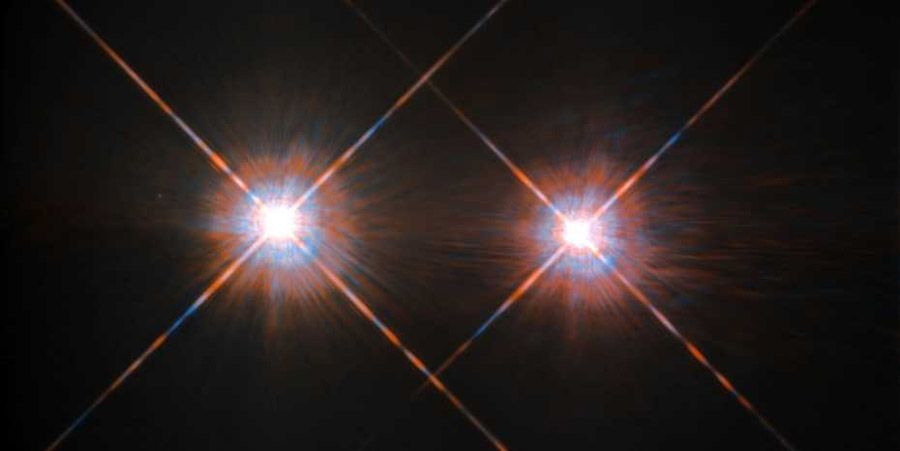Earth’s Big Brother: If there was a planet in the nearby binary star system Alpha Centauri, it might be similar to Earth in many ways, models based on spectroscopic data reveal. So the exoplanets would have an iron core slightly larger than Earth, an Earth-like rock mantle with a slightly higher graphite/diamond ratio and a gaseous shell similar to Earth’s original atmosphere.
The red dwarf Proxima Centauri and the binary star Alpha Centauri are our closest neighbors in space – and therefore potential targets for future interstellar space missions. However, while about Proxima Centauri already three planets was discovered, Chase Still in Alpha Centauri. Since its stars are similar to the Sun and not very active, an exoplanet in this system would be a more promising candidate for a “second Earth” or even life in space.
Actually there The first clues to an exoplanet around Alpha Centauri, possibly orbiting in the habitable zone of Alpha Centauri A. However, there is still no confirmation whether the “suspicious” point of light really comes from a planet.
What could Alpha Centauri look like?
The question of how such an Earth-like and habitable planet could be in the Alpha Centauri system is even more exciting. This is exactly what ETH Zurich’s Haiyang Wang and colleagues have achieved in detail for the first time. They used spectroscopic data on the chemical composition of the two stars, as well as models of planetary composition and the elemental composition of planetary systems, to determine possible features of a rocky Earth-sized planet in the habitable zone of Alpha Centauri A or B.
The result of this modeling is a detailed image of this hypothetical “Alpha Centauri Earth”, including its internal structure, mineralogy and atmospheric composition. The latter is particularly an important advance because the distribution of volatile elements in planetary systems is much more difficult to predict than the distribution of rocks or minerals. Even in the case of Earth, it has not yet been fully clarified where it got its water and atmosphere from.
The basic structure is very similar
So what does a potential Earth twin look like around Alpha Centauri? According to the models, the basic structure of this planet corresponds to the structure of the Earth: it has an iron core surrounded by a rocky mantle and atmosphere. However, in the details, there are some differences: Alpha Centauri’s mineral core will be slightly larger than Earth’s — it makes up 38 percent of the mass instead of 32 percent of Earth, the team reported.
Like Earth, the rocky mantle of the planet Alpha Centauri is composed primarily of silicates. Olivine mineral predominates in the upper mantle, as in the ground mantle, while perovskite minerals predominate in the lower mantle. However, because the two stars in the Alpha Centauri system have a higher carbon content than our Sun, the proportion of this element could also be higher in the planet’s mantle: “Native carbon species such as graphite and diamond can be enriched there,” Wang and his team report.
Volcanoes and tectonic plates are likely to be absent
These interior features also provide some clues as to what the planet’s surface might look like. As the team determined, heat exchange between the deeper layers and the surface may not have been enough to initiate active convection in the mantle. Therefore, there are probably no true tectonic plates on the planet Alpha Centauri Earth.
“This in turn means that there is less volcanic activity and less gaseous gases on our model planet,” Wang and his team explain. Thus, the processes that shape the distribution of land masses, the formation of mountains and mountains on Earth can be absent or develop only weakly on this nearby exoplanet.
Mantle rocks can be rich in water
However, there are significant similarities in the transitional region from the upper to the lower mantle. On Earth, at a depth of about 410 km, olivine turns into the more compact minerals ringwoodite and wadislite. The exciting thing about it: ringwoodite and wadsleyite can a lot of water incorporated into its crystal structure. As a result, the transition layer in the Earth’s mantle could contain more water than all of the world’s oceans combined.
For the planet Alpha Centauri, this means: “Very similar amounts of wadsleyite and Ringwoodite and a similar ratio of olivine to pyroxene reveal that this planet should have the same water storage capacity as Earth,” according to the scientists’ report. Although this says nothing about the amount of water on the planet or its availability, it does provide initial indications of the ease of life.
The atmosphere is like the primitive earth
It is also interesting to ask about the atmosphere of an Earth-like planet around Alpha Centauri. The team determined that its gaseous envelope could be staggeringly similar to that of the early Earth. Accordingly, carbon dioxide, methane and water vapor predominate in the atmosphere of the planet Alpha Centauri Earth – just like originally on our planet. Only with the emergence of the first forms of life did the original atmosphere of the Earth change and became rich in nitrogen and oxygen.
“Of course, we have no way of predicting a similar change to our Alpha Centauri Earth,” emphasizes Wang and colleagues. Because it depends on whether life has also evolved on this close neighbor. If not, Alpha Centauri’s atmosphere could be dry and carbon dioxide-rich today.
Earth’s Big Brother
In general, astronomers paint a picture of a planet very similar to Earth in many key features. Since the stars of Alpha Centauri are one and a half to two billion years older than the Sun, their planet will be a kind of big brother to our Earthly home. But it remains to be seen if it exists.
After all, the chances of the research being successful are especially good in the next few years. Because from 2022 to 2035, the two stars of this double system will move the maximum distance from each other. This makes it easy to pick up a potentially faint signal of the planet despite the stellar chaos. (Astrophysical Journal, 2022; doi: 10.3847/1538-4357/ac4e8c)
Source: ETH Zurich

“Total coffee aficionado. Travel buff. Music ninja. Bacon nerd. Beeraholic.”







More Stories
“His presence speaks powerfully.”
Experts informed patients about the topic of cervical cancer
'Gaia BH3': A massive black hole lurks here – a falling star that led to the discovery